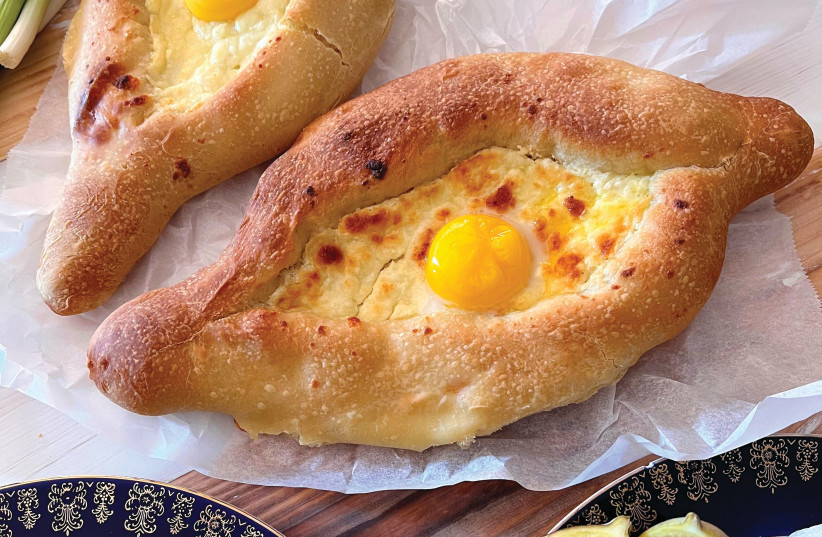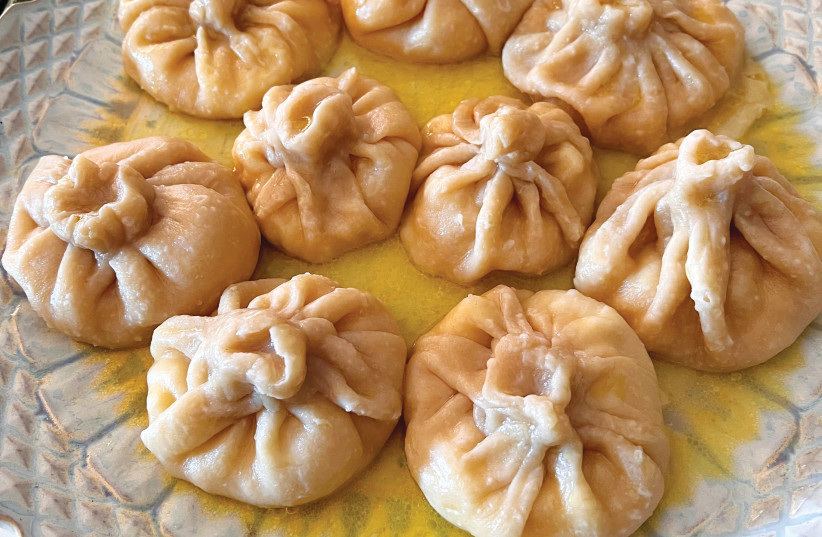The best way to familiarize yourself with a new culture is by sampling its cuisine. You can learn so much about people by the aroma and flavors of the traditional dishes they serve. This week, we are going to delve into Georgian cuisine, which is replete with a host of incredibly juicy and rich dishes.
You’ll find a wide variety of herbs, wheat, cheese, potatoes, apples, onions and garlic in recipes hailing from Georgian cuisine. Many recipes for savory and sweet dishes also include walnuts. Fish is often cooked in walnut sauce, and walnuts are included in the filling for stuffed eggplant and zucchini recipes, too. Moreover, these nuts appear in a large number of traditional desserts served in Georgia.
I was surprised to learn that lemon is almost never used in Georgian cuisine in salads or cooked dishes. Instead, pomegranate juice, plums, green plum sauce and alcohol are used in both savory and sweet dishes. Another interesting tidbit I discovered is that oftentimes, a pinch of ground chili pepper is added to desserts to give them a little punch. A typical Georgian meal consists of salads, pickled vegetables, and a wide variety of cheeses, such as sulguni cheese.
Georgian desserts include a number that were borrowed from other regions, such as Napoleon mille-feuille puff pastry from French cuisine and debla from North African cuisine, which are called burbushella in Georgia. Other examples include baklava, which is also popular in Turkish, Greek, Iraqi and Kurdish cuisine, and is called pahlava in Georgia.
I was having a hard time deciding which recipes to include in the column this week, so I decided to invite to my kitchen chef Avi Dan Dadiashvili, who grew up eating traditional Georgian food. Avi, 40, and father of three, says that while growing up, his family was always hosting guests in their home for meals that were full of authentic Georgian dishes, good music and, of course, plenty of chacha, a Georgian grape brandy.

Avi began experimenting in the kitchen at a very young age and worked long hours in catering as a teen to help out his family with expenses. He then went on to train at the Ort Zerifin Culinary Arts program, followed by jobs as a sous-chef at hotels and wedding halls, such as Keter Harimon in Bnei Brak, and as a chef at Kfar Maccabiah.
Avi is currently running a kosher-concept gourmet catering business overseas.
Avi helped me choose three of his favorite pastry recipes that offer a little taste of Georgian cuisine. All three of them include cheese filling that can easily be swapped out for meat or vegetarian fillings.
I hope you enjoy preparing these tasty Georgian pastries.
Khachapuri Megruli (Georgian Cheese Bread)
Makes 3 loaves with a 22cm-24cm diameter.
Dough:
- 650 gr. white flour
- 12 gr. dry yeast
- 30 gr. butter, softened
- 8 gr. sugar
- 300 ml. water at room temperature
- 8 gr. salt
- 22 ml. canola oil
Filling:
- 200 gr. mozzarella cheese, grated
- 120 gr. sulguni cheese, grated
- 220 gr. Tzfat cheese, grated
- 2 large eggs
Bread wash:
- 20 gr. butter, melted
Topping:
- 30 gr. Parmesan cheese, grated
Place all of the dough ingredients in the bowl of an electric mixer and knead until the dough is mixed well, soft, smooth and elastic. Cover the bowl and let the dough rise for 20 minutes. Then knead the dough again and separate it into 3 balls. Cover the 3 balls, and let the dough rise for another 20 minutes.
Add all of the filling ingredients to a separate bowl and mix well.
Flour your work surface, then roll out each ball into a thin sheet, 1 centimeter thick. Spread one-third of the filling in the center of each dough circle. Lift up the edge of the dough circle and press it down on top of filling. Then, roll the dough up into a ball. Turn the balls over and roll them out on a floured surface, so that the open cheese part is facing down. Let the dough rise for another 20 minutes.
Place the dough with the open side facing down on a tray covered with baking paper. Gently roll the dough out until each one is 2 centimeters thick, with a diameter of 22 – 24 centimeters. Let the dough rise for another 15 minutes, then bake in a preheated oven on 180° for 14 minutes.
Remove from the oven and brush with butter. Sprinkle Parmesan cheese on top and then place the bread back in the oven for 5 minutes. Serve hot.
Level of difficulty: Medium
Time: 90 minutes
Status: Dairy

Khachapuri Adjaruli (Georgian Cheese Bread Boat)
Makes 8 cheese bread boats.
Dough:
- 1 kg. dough, sifted
- 15 gr. dry yeast
- 8 gr. sugar
- 1 large egg
- 100 ml. oil
- 250 ml. water at room temperature
- 8 gr. salt
Filling:
- 500 gr. Canaan cheese
- 500 gr. sulguni cheese
- 150 gr. mozzarella cheese, grated
- 1 large egg
Topping:
- 8 eggs
Place all of the dough ingredients in the bowl of an electric mixer and mix until dough is mixed well, soft, smooth and elastic. Transfer the dough to a floured work surface and knead the dough for 5 more minutes. Place the dough in a lightly greased bowl and let it rise in a warm place for 1 hour or until it doubles in volume.
Separate the dough into 8 sections, so that each section weighs 150 grams. Roll each section into a ball, and then let them rise for another 30 minutes.
In a medium bowl, mix together all of the filling ingredients. Lightly flour your work surface and roll out each of the dough balls until they are 1 centimeter thick. Spread an equal amount of filling in the middle of each circle, and spread it out a little. Roll up the dough from the far side, and also from the side closest to you, leaving the area with the filling exposed. Press each of the ends together of the rolled-up dough so that it forms a boat shape. Prepare all the boats in the same fashion.
Place the boats on trays covered with baking paper. Bake in an oven that has been preheated to 220° for 16 minutes until they’ve crisped up. Remove the boats from the oven, and place a raw egg in the center of each boat. Return the boats to the oven to cook for another 3 minutes.
Level of difficulty: Medium
Time: 90 minutes
Status: Dairy

Khinkali (Georgian Cheese Dumplings)
The way to eat the dumplings is to hold each one` by the tip and place the whole dumpling in your mouth, without eating the tip.
Makes 16 dumplings with a 10-cm. diameter.
Dough:
- 1 kg. white flour
- 1 egg
- 9 gr. salt
- Around 2 cups tap water (depends on absorbency rate of flour)
Filling:
- 450 gr. sulguni cheese, grated
- 300 gr. Canaan cheese
- 1 egg
Serving suggestion:
- 50-60 gr. butter, cubed
In a large bowl, mix all of the dough ingredients. While mixing, gradually add the water until the dough is firm and elastic. Cover the bowl and let the dough rest for 1 hour.
In a separate bowl, mix all of the filling ingredients together.
Roll out the dough until it’s really thin with a rolling pin or a pasta machine. Cut out circles of dough with a 10-centimeter diameter. Place a spoonful of filling in the middle of each circle. Then, fold the sides of the dough up so that it’s all folded up like a pleated skirt (see pictures). Secure the ends together and twist the dough to close it tightly. Tear off any extraneous dough. Prepare all the dumplings in the same fashion.
Fill a large pot with water and add a teaspoon of salt. Bring the water to a boil, then add the dumplings, stirring continuously until the dumplings pop up and float on top. Cook for another 7 minutes. Remove dumplings with a slotted spoon and place on a serving dish. Add butter cubes on top and serve.
Level of difficulty: Medium-difficult
Time: 90 minutes
Status: Dairy
Translated by Hannah Hochner.
